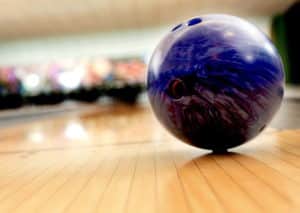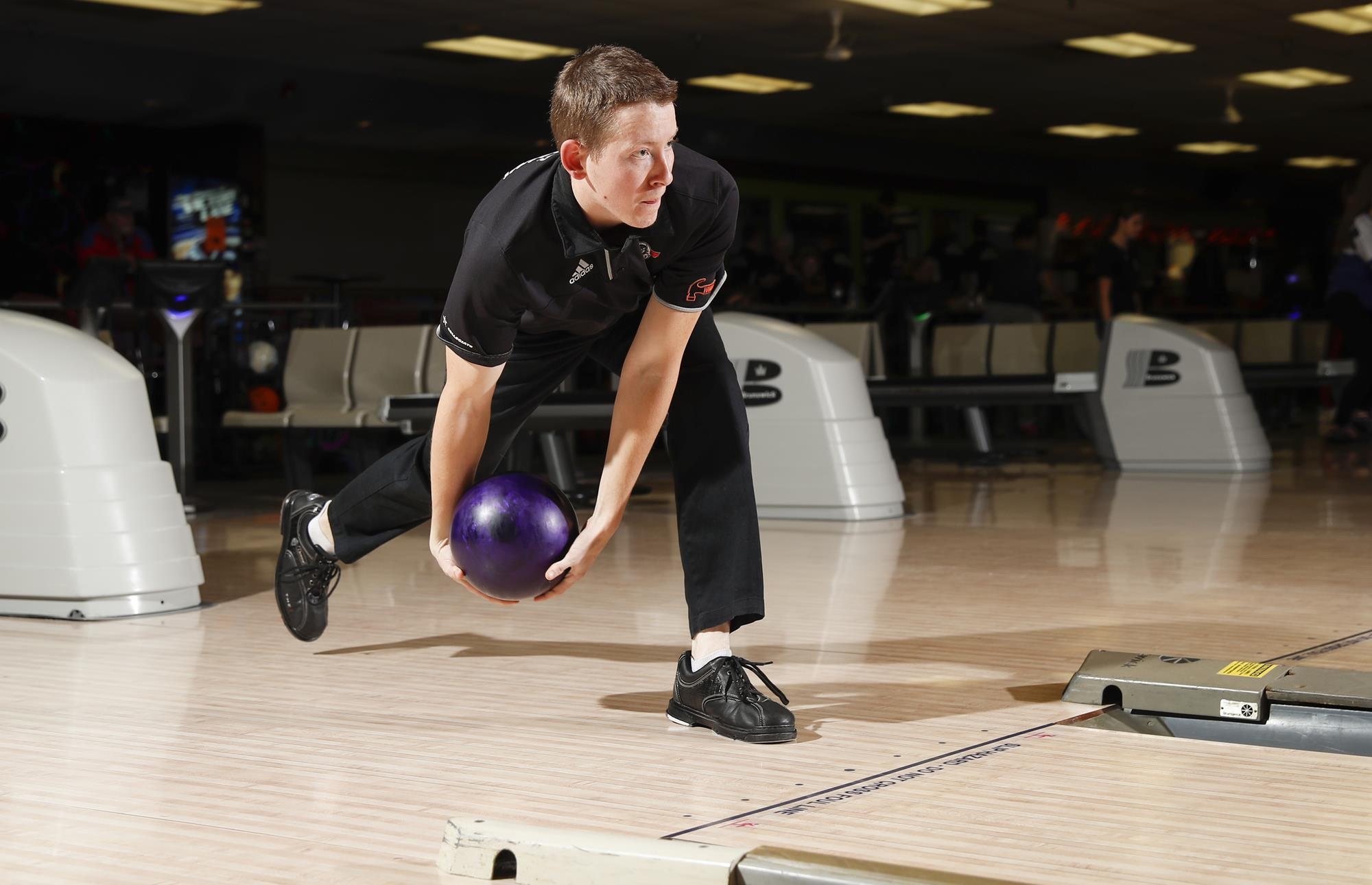Bowling is a dynamic sport that offers a perfect blend of physical activity and enjoyment. It provides an excellent opportunity to exercise and engage your body while having a great time.

Bowling is no longer just for kids. Countless adults have become avid fans of this enjoyable activity, flocking to it in large numbers.
Whether you’re a novice bowler or aiming to enhance your score, this comprehensive guide has got you covered. Dive in to discover all the essential tips and tricks you need to succeed on the lanes.
Contents
What Is Bowling?
Bowling is an engaging game where players skillfully roll a ball down an alley, strategically aiming to knock over pins placed at different points along the lane. The objective is to gracefully topple all the pins before they touch the ground, requiring precise control and technique.
Each pin knocked over adds one point to your score, meaning that if you knock over 10 pins, you earn 10 points. The objective is to accumulate the highest number of points in each frame, and the better your average score, the more skilled you are considered to be.
The Rules Of Bowling
When it comes to bowling, there are two rules that you need to keep in mind:
- You are allowed only one bowl per frame. This implies that you must wait until the current frame is completed before bowling again.
- The ball must be released from your hand before it makes contact with the floor.
Failure to adhere to these rules will result in disqualification from the match. However, there are additional rules and regulations to be aware of to become a successful bowler.
A History of Bowling
Bowling, a beloved activity, has been enjoyed by enthusiasts for millennia. Evidence of its ancient roots was discovered when a set of stone pins was unearthed from an Egyptian grave, suggesting their intended use in a form of bowling during the Ancient Egyptian era.
Since its inception, bowling has undergone continuous growth, evolution, and development, resulting in the emergence of two distinct forms: lawn bowling and pin bowling.
Lawn bowling is a delightful outdoor game played on lush green surfaces like parks, golf courses, and open spaces. It involves using balls that weigh approximately 6 to 8 ounces and is typically played in three frames. Additionally, there are intriguing variations of this bowling style, such as cricket and rugby-style bowls.
Pin bowling is typically played indoors on hard floors such as gymnasiums, warehouses, and bowling alleys. It is commonly played with six frames, although certain variations may use fewer frames. The standard diameter of a bowling ball used in pin bowling is approximately 7 1/2 inches.
Bowling in the United States owes its popularity to immigrants from England, Germany, and Scotland. However, it wasn’t until the 19th century that bowling truly emerged as a beloved pastime across America.
During the late 1800s, bowling alleys sprouted across the nation, captivating Americans and turning bowling into a beloved pastime. By 1900, a staggering 3,000 bowling centers dotted the U.S., with the average American bowler hitting the lanes at least once a week.
Bowling’s popularity surged in the 20th century, attracting around 30 million active bowlers in the U.S. by 1950. Even today, it remains one of the world’s fastest-growing sports.
Key Terms In Bowling
Bowling has a captivating charm in its simplicity – it’s a game that anyone can quickly pick up, with even children effortlessly joining in without any prior experience. This accessibility is one of its greatest strengths, making it a delightful pastime for people of all ages.
Mastering the art of the perfect bowling shot requires practice, dedication, and time. To become a skilled bowler, it’s crucial to devote sufficient time to honing your skills. Practice is key to improving your bowling abilities and achieving success in this sport.
Before you start bowling, it’s important to have a good grasp of the main vocabulary and terms you should know. These include:
Bowl
The bowling equipment consists of the essential component responsible for launching the ball. A standard bowling ball weighs approximately 5 to 7 pounds and has a circumference ranging from 9 to 13 inches.
Stroke
Mastering the art of propelling the ball forward is crucial in bowling. When you bowl, your objective should be to strike the ball in a manner that maximizes its velocity and allows it to gracefully soar through the air.
Ball Grip
How you grip the ball affects your control while bowling. If you’re new to bowling, try holding the ball with your thumb facing away from you and your fingers wrapped tightly around the sides.

Release Point
The release point in bowling is crucial as it determines where you release the ball. For optimal results, aim to release the ball at the peak of its trajectory, ensuring a straight and accurate path toward the target.
Target Line
The target line in bowling indicates the intended destination for the ball upon release. Properly aligning your throw is crucial, as missing the target line may result in insufficient distance for the ball to reach the pins.
Pins
The pins serve as the targets that you aim to knock down. Aligned in a row across the alley, they are numbered from left to right. Each pin represents a frame or a 10-foot section of play, adding structure and organization to the game.
Strike Zone
The strike zone refers to the area of the lane where you should aim your ball. This area extends outwards from the centerline of the lane, and it is divided into two zones by a red line. For you to score points, you must hit the pins inside the white circle.
Scoreboard
A scoreboard showcases the count of strikes and spares achieved in every game. These numbers can be found either on the wall behind the lanes or on a separate display board positioned near the scoring boxes.
Scoring Boxes
These small boxes, known as pin boxes, are an integral part of the game. Each box contains the pins that are knocked down during a particular frame. Printed on each box is a number that corresponds to the number of points you earn for successfully toppling that specific pin. This scoring system adds an extra layer of excitement and strategy to the game, as players aim to maximize their points by strategically targeting and knocking down the pins.
Types of Bowling Balls
In today’s market, there is a wide selection of bowling balls to choose from. Each ball is uniquely designed to cater to specific player types, while others are tailored for those with prior experience in the sport.
When selecting a ball, various factors come into play, such as your budget, style preferences, and personal tastes. Make a choice that aligns with your needs and enjoy the game to the fullest. Below are some popular types of bowling balls available on the market today:
Professional Series
The Professional series balls boast a sophisticated design, catering to the needs of dedicated bowlers. These balls are available in a range of weights, starting from 6 pounds and going up to 12 pounds.
Standard Series
Bowling balls designed for beginners provide a solid foundation for learning proper form and technique. These balls, commonly referred to as “household” balls, are typically crafted from plastic or rubber and weigh between 5 and 7 pounds. They are tailored to facilitate the learning process and help bowlers develop their skills effectively.
Economy Series
Economy series balls are meticulously crafted to deliver exceptional performance while being budget-friendly. These balls are offered in standard and heavy-weight options, providing versatility to suit individual preferences.
Tournament Series
Tournament series balls are meticulously crafted for high-level competitions, and specifically tailored to meet the demands of professional tournaments. These balls typically possess a weightier composition compared to other bowling balls and are often constructed using premium materials, including metal alloys.
Tournament series balls are designed with a unique surface coating that enables them to achieve faster and more accurate rolls compared to other bowling balls. These balls can have a maximum weight of 16 pounds.
Household Balls
Household bowling balls are specifically crafted for individuals with no prior experience in the sport. These balls are typically constructed from gentle rubber or plastic materials and weigh less than 2 pounds.
Heavyweight Balls
Heavyweight bowling balls are specifically engineered to endure elevated levels of stress and pressure. Typically constructed from steel or aluminum alloy, these balls can range in weight from 10 to 14 pounds.
Bowling balls not only vary in series but also in a multitude of shapes and sizes. For instance, certain balls are specifically crafted to assist beginners in mastering the proper grip, while others are tailored for the seasoned bowlers’ skilled hands.
Tips for Buying a Bowling Ball
When searching for the perfect bowling ball to suit your needs, consider these tips:
Choose the Right Size
When starting, opt for a ball size that aligns with the size of your hand. This ensures a comfortable grip during practice sessions. As your skills progress, consider gradually increasing the size of the ball to further enhance your performance.
The weight of the ball can be influenced by the size of your hand. If you are left-handed, it is recommended to use a left-handed ball. Left-handed players often experience a natural difference in how their hands grip the ball compared to others, which can result in consistency issues.
Generally, people with smaller hands tend to find lighter balls more advantageous, whereas those with larger hands may prefer heavier balls for better suitability.
Consider Weight
If you intend to use your bowling ball frequently, it’s important to choose a weight that feels comfortable in your hands. Additionally, if you have plans to participate in tournaments, you might consider investing in a heavier ball.
Look for Durable Materials
Bowling balls are typically crafted from resilient materials such as polyurethane, ensuring their longevity. For those seeking even greater durability, consider selecting balls that have been manufactured using top-notch materials.
How To Choose A Ball That Feels Comfortable
When choosing a bowling ball, it’s important to consider its comfort level as well. Some balls may feel excessively lightweight, while others might come off as overly heavy.
Check the Surface
While the majority of bowling balls boast a smooth surface, certain manufacturers provide options with a rougher finish. The roughness of the ball’s surface directly impacts the amount of friction generated between the ball and the lane, ultimately enhancing your chances of striking the pins.
Test It Out
Before purchasing a bowling ball, it’s advisable to give it a test run at a nearby bowling alley. Ensure that the ball fits snugly in your hand and rolls effortlessly along the lanes. This way, you can guarantee both comfort and smooth performance.
Today, a wide variety of bowling balls are readily available, each with its own set of advantages and disadvantages. To select the ideal weight that suits your requirements, consider the following guidelines:
Consider Your Experience
If you’re a beginner in the sport, opting for a medium-weight ball is recommended. These balls usually weigh between 16 and 20 pounds, striking a balance between speed and accuracy enhancement. Incorporating such a ball into your practice can help you improve your agility and precision.
Beginners are often advised to start with a medium-weight ball as it is easier to handle and throw accurately. However, if you are an experienced player looking to enhance your game, opting for a heavier ball might be more suitable for you.
Consider Your Game Style
Optimizing the ball’s weight can greatly impact your performance. A lighter ball facilitates quicker movements, but sacrifices power. Conversely, a heavier ball yields more power, yet demands greater effort to utilize effectively.
If you intend to compete regularly, it is advisable to opt for a heavier ball. Heavy balls are typically crafted for tournament play, ensuring optimal performance and gameplay experience.
Find A Ball With Good Durability
When purchasing a bowling ball, it is important to also take durability into account. Seek out a ball constructed from high-quality materials that are designed to withstand the test of time.
Think About What You Want From The Ball
Think about whether you want a fastball or a powerful ball, a smooth ball or a firm ball. When choosing a ball to purchase, several factors need to be taken into consideration. To simplify the shopping process, it is crucial to carefully ponder these questions and narrow down your options accordingly.
How Should You Hold A Bowling Ball?
After selecting the ideal bowling ball that suits your requirements and budget, it is crucial to understand the proper technique for gripping it. Here are some fundamental pointers to consider:
Grip the Ball Properly
A crucial aspect to bear in mind is the proper grip of the ball. If you clutch the ball too tightly, releasing it becomes a challenge. To achieve this, position your thumb at the center of the ball and encircle it with your fingers.
Keep Your Elbow Straight
To maintain proper form, ensure that your elbow remains straight while holding the ball. Bending your arm could lead to potential injury or damage to your bowling ball.
Bend Your Wrists Slightly
Gently flex your wrists to establish a secure grip on the ball, ensuring comfort without straining your arms.
Relax Your Fingers
Maintain a relaxed grip on the ball, ensuring that your fingers are not tense. Tension in your muscles can lead to pain and injury, so it’s important to focus on relaxing your entire body instead. By doing so, you can optimize your performance, enhance readability, and ensure eloquence, all while conveying the same meaning as the original content.
Practice Makes Perfect
With practice, you will grow familiar with the sensation of the ball in your hands. Once you have mastered the fundamentals, you will be prepared to elevate your game to new heights.
Bowling Tips
Discover these valuable suggestions to enhance your gaming skills and skyrocket your bowling score:
Start With a Smooth Roll
When you begin playing, there’s no need to obsess over rolling the ball flawlessly. Instead, focus on effortlessly guiding the ball through the air. You can even practice this motion without the bowling ball at first. This will help you become accustomed to the movement and its nuances.
Aim For Accuracy
To achieve accuracy in bowling, it is crucial to aim for the middle of the lane when striking the pins. Avoid targeting the edges of the lane where the pins are typically positioned; instead, focus on delivering the ball precisely down the center. This approach will enhance your chances of hitting the pins with precision and consistency.
Mastering this skill requires dedicated practice. Be ready to invest time and energy – consistent repetition and regular training will enhance your accuracy and overall performance.
Follow Through
Follow-through is the art of maintaining your arm extended even after the ball is released. This simple yet crucial technique guarantees a longer travel distance of the ball down the lane. It is an integral part of achieving excellence in bowling.
Know How to Swing
The art of swinging is a fundamental aspect of bowling. The objective is to fluidly move your arm back and forth with swiftness, generating the necessary force to propel the ball toward the pins.
Focus On Timing
Timing is crucial in bowling as it determines when to release the ball. The goal is to release the ball right before the pin reaches its peak, ensuring the highest chance of success.
Watch Where You Strike
Observing the outcome when you make contact with the pins can enhance your ability to achieve more effective strikes. Take note of the ball’s trajectory, whether it rebounds or veers to a particular side. By paying close attention to these details, you can refine your technique and improve your overall performance.
Learn How to Throw
To execute a successful throw, it is crucial to engage both your upper and lower body in a synchronized motion. This skill demands a combination of strength and coordination.
Be Patient
Developing patience is crucial when learning how to bowl. It requires time and practice to cultivate proper form and master the techniques.
Enjoy!
One of the key aspects to remember when playing is to have fun. When you genuinely enjoy the sport, your chances of enhancing your skills and raising your average score substantially improve.
Wrap-up
Mastering the art of throwing and propelling a bowling ball is the foundation for confident and fun throwing for future matches. The true secret to triumph in this sport lies in relentless practice.
Luckily, bowling is a delightful pursuit that never loses its charm. So, hone your skills and bask in the sheer joy it brings!


Allow me to introduce myself – I’m Eric Wilkinson, a true bowling aficionado. The world of bowling culture has always fascinated me, and I’ve made the exciting decision to share my passion through writing. As I embark on this blogging adventure, my goal is to provide fellow enthusiasts with valuable insights, tips, and captivating stories. Through my blog, I hope to ignite a deeper appreciation for the sport and foster a sense of community among fellow bowlers. Join me on this thrilling journey as we explore the vibrant world of bowling together.
